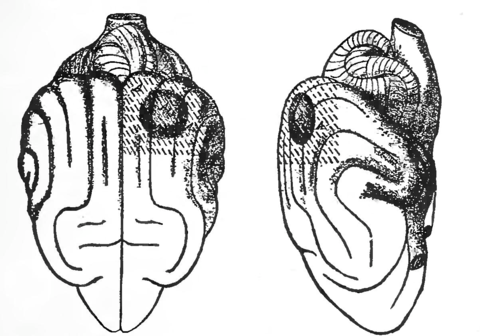sphäre' definitely, and says that blindness must result when the entire shaded part, marked A, A, in Figs. 12 and 13, is involved in the lesion. Discrepant reports of other observations he explains as due to incomplete ablation.

Fig. 12.Fig. 13.
The Dog's visual centre according to Munk, the entire striated region, A, A, being the exclusive seat of vision, and the dark central circle, A', being correlated with the retinal centre of the opposite eye.
Luciani, Goltz, and Lannegrace, however, contend that they have made complete bilateral extirpations of Munk's Sehsphäre more than once, and found a sort of crude indiscriminating sight of objects to return in a few weeks.[1] The question whether a dog is blind or not is harder to solve than would at first appear; for simply blinded dogs, in places to which they are accustomed, show little of their loss and avoid all obstacles; whilst dogs whose occipital lobes are gone may run against things frequently and yet see notwithstanding. The best proof that they may see is that which Goltz's dogs furnished: they carefully avoided, as it seemed, strips of sunshine or paper on the floor, as if they were solid obstacles. This no really blind dog would do. Luciani tested his dogs when hungry (a condition which sharpens their attention) by strewing
- ↑ Luciani und Seppili: Die Functions-Localization auf der Grosshirnrinde (Deutsch von Fraenkel), Leipzig, 1886, Dogs M, N, and S.Goltz in Pflüger's Archiv, vol. 34, pp. 490–6; vol. 42, p. 454.Cf. also Munk: Berlin Akad. Stzgsb. 1886, VII, VIII, pp. 113–121, and Loeb: Pflüger's Archiv, vol. 39, p. 337.
